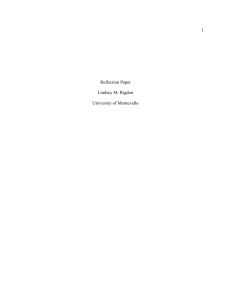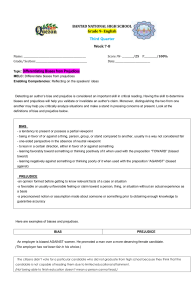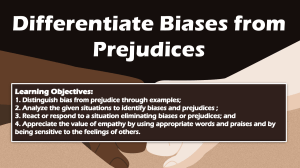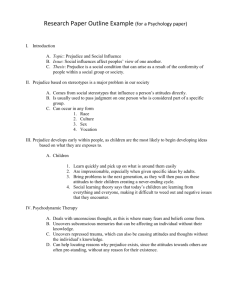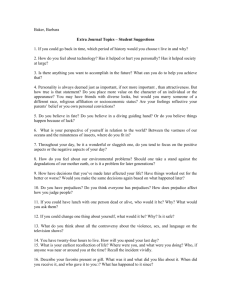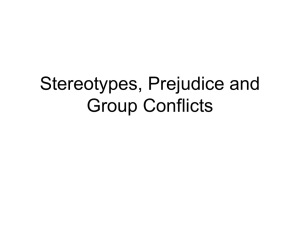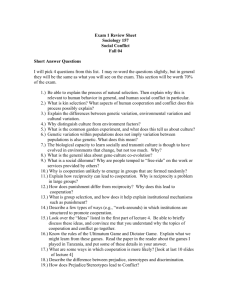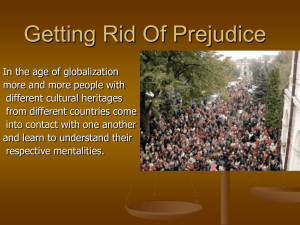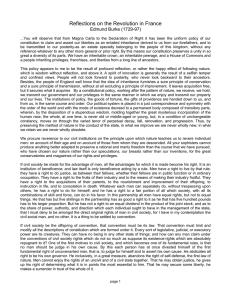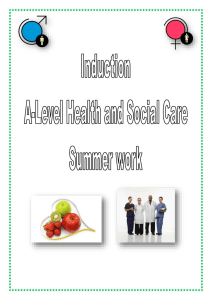001_-_unit_1_-_assignment_1
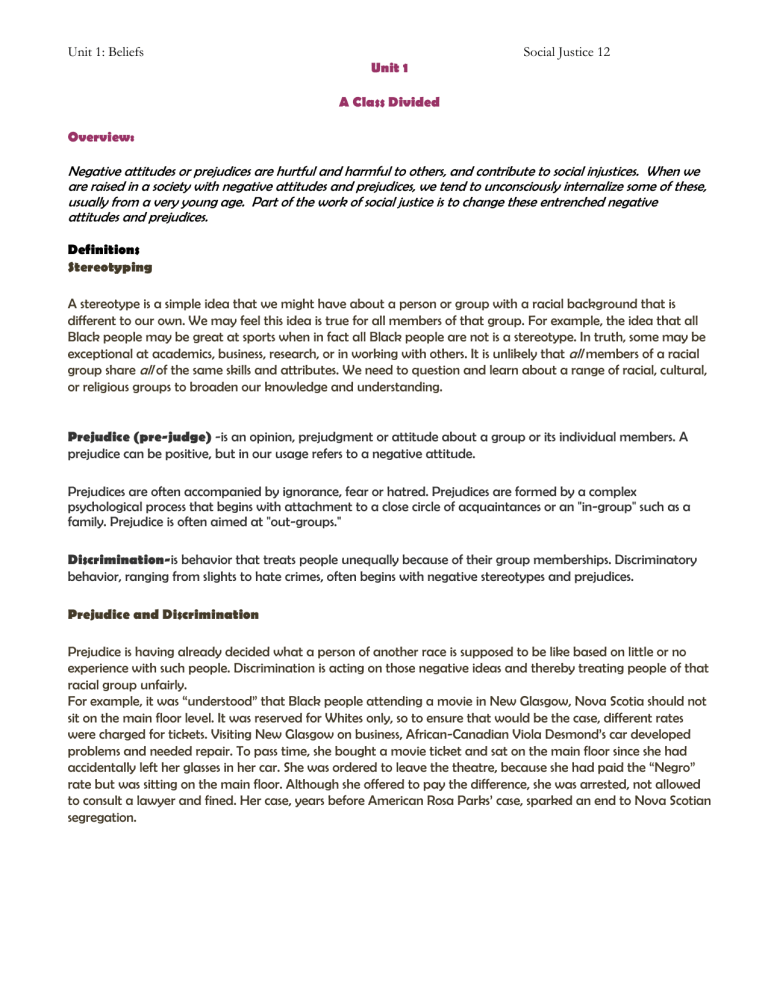
Unit 1: Beliefs
Unit 1
A Class Divided
Social Justice 12
Overview:
Negative attitudes or prejudices are hurtful and harmful to others, and contribute to social injustices. When we are raised in a society with negative attitudes and prejudices, we tend to unconsciously internalize some of these, usually from a very young age. Part of the work of social justice is to change these entrenched negative attitudes and prejudices.
Definitions
Stereotyping
A stereotype is a simple idea that we might have about a person or group with a racial background that is different to our own. We may feel this idea is true for all members of that group. For example, the idea that all
Black people may be great at sports when in fact all Black people are not is a stereotype. In truth, some may be exceptional at academics, business, research, or in working with others. It is unlikely that all members of a racial group share all of the same skills and attributes. We need to question and learn about a range of racial, cultural, or religious groups to broaden our knowledge and understanding.
Prejudice (pre-judge) -is an opinion, prejudgment or attitude about a group or its individual members. A prejudice can be positive, but in our usage refers to a negative attitude.
Prejudices are often accompanied by ignorance, fear or hatred. Prejudices are formed by a complex psychological process that begins with attachment to a close circle of acquaintances or an "in-group" such as a family. Prejudice is often aimed at "out-groups."
Discriminationis behavior that treats people unequally because of their group memberships. Discriminatory behavior, ranging from slights to hate crimes, often begins with negative stereotypes and prejudices.
Prejudice and Discrimination
Prejudice is having already decided what a person of another race is supposed to be like based on little or no experience with such people. Discrimination is acting on those negative ideas and thereby treating people of that racial group unfairly.
For example, it was “understood” that Black people attending a movie in New Glasgow, Nova Scotia should not sit on the main floor level. It was reserved for Whites only, so to ensure that would be the case, different rates were charged for tickets. Visiting New Glasgow on business, African-Canadian Viola Desmond’s car developed problems and needed repair. To pass time, she bought a movie ticket and sat on the main floor since she had accidentally left her glasses in her car. She was ordered to leave the theatre, because she had paid the “Negro” rate but was sitting on the main floor. Although she offered to pay the difference, she was arrested, not allowed to consult a lawyer and fined. Her case, years before American Rosa Parks’ case, sparked an end to Nova Scotian segregation.
Unit 1: Beliefs
The Assignment:
1. Watch the following case study called, ‘A Class Divided’. Links are provided:
Social Justice 12 http://www.pbs.org/wgbh/pages/frontline/shows/divided/etc/view.html
OR http://video.google.ca/videosearch?q=a+class+divided&hl=en&emb=0&aq=0&oq=A+Class+#q=Education%2C+Soci ology%2C+Pedagogy+a+class+divided&hl=en&emb=0
2. Create a journal entry where you write down what you are thinking. Respond to the following questions in your journal: a) What are your feelings/thoughts about the case study you just watched? b) Are there any negative attitudes/stereotypes that you hold toward particular groups or individuals in society? c) Why do you think people hold negative views or stereotypes about others? d) How do you think people acquire these views? e) What are the basic values underlying such views? f) How is society affected when such views are held by a large number of people?
You are not limited to the above questions (feel free to write more!). Your response must be at least 2 paragraphs in length.
Ensure that you have checked your spelling and grammar before handing it in!
Mark Breakdown:
= Not met = Weakly met = Average = strong
= very strong
COMPLETE
MARK
/ 20
COMMENTS
Journal entry meets the requirements of assignment. Questions (a) to (e) are answered.
/10 DEVELOPED Includes examples and details. Attempts to explain and communicate ideas!
INSIGHTFUL Shows deep understanding of topic/ideas. Goes beyond the obvious.
FLUENT Organization of journal is clear and easy to follow.
Smooth flow from one idea
/10
/5
READABLE to another.
Spelling, grammar and punctuation are accurate.
Neatly typed or hand written.
/5
TOTAL /50
Unit 1: Beliefs Social Justice 12
